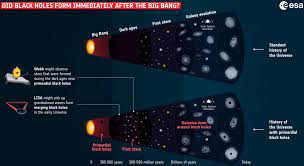Black Holes: Probing the Depths of Space and Time.
Black holes are among the most fascinating and mysterious objects in the universe. These regions of space-time are so dense that nothing, not even light, can escape their gravitational pull. For many years, black holes were purely theoretical objects, but with the development of new observational techniques, astronomers have been able to study them in increasing detail.
What is a Black Hole?
A black hole is a region of space-time where the gravitational pull is so strong that nothing can escape from it, not even light. The boundary around a black hole, beyond which nothing can escape, is known as the event horizon. The size of the event horizon depends on the mass of the black hole, with larger black holes having larger event horizons.
Black holes are formed when massive stars collapse in on themselves at the end of their lives. The collapse is so intense that the gravitational pull becomes infinite, and the star collapses to a point of zero volume and infinite density known as a singularity. The black hole is surrounded by an accretion disk, a disk of gas and dust that is heated by friction and emits X-rays.
Studying Black Holes
Despite the fact that black holes cannot be directly observed, astronomers can still study them using indirect techniques. One way is to observe the effects of black holes on nearby matter. For example, the presence of a black hole can cause nearby stars to orbit around it, and astronomers can measure the velocities of these stars to determine the mass of the black hole.
Another way to study black holes is through the observation of their effects on light. When a black hole is surrounded by an accretion disk, the disk emits X-rays that can be observed by telescopes. By studying the X-ray emissions, astronomers can infer the size and mass of the black hole, as well as the properties of the surrounding disk.
In addition to X-ray emissions, black holes can also emit jets of material that travel at relativistic speeds. These jets can be observed using radio telescopes, and can provide information about the structure of the black hole and the accretion disk.
Black Holes and General Relativity
Black holes are also important for our understanding of the universe at large. They are predicted by the theory of general relativity, which describes the nature of space-time and the behavior of gravity. Black holes are extreme examples of the predictions of general relativity, and studying them can provide insights into the behavior of space-time and the nature of gravity.
In recent years, the study of black holes has led to the discovery of gravitational waves, ripples in space-time that are generated by the acceleration of massive objects, such as black holes. The detection of gravitational waves has opened up a new window into the universe, and has allowed astronomers to study the behavior of black holes and other massive objects in unprecedented detail.
Conclusion
Black holes are among the most mysterious and intriguing objects in the universe. While they cannot be directly observed, astronomers have been able to study them using a variety of indirect techniques. These studies have provided insights into the behavior of space-time and the nature of gravity, and have led to the discovery of new phenomena, such as gravitational waves. As our observational techniques continue to improve, we are likely to gain even more insights into the mysteries of black holes and the universe at large.





0 Comments:
Post a Comment
Subscribe to Post Comments [Atom]
<< Home